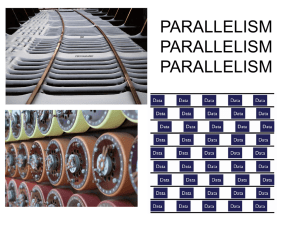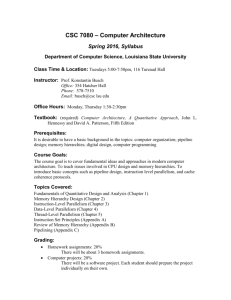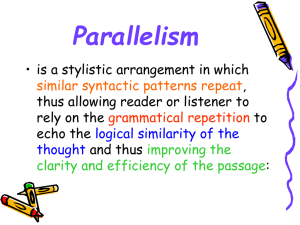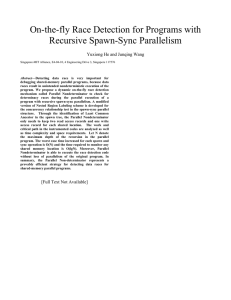CS 61C: Great Ideas in Computer Architecture (Machine Structures) Instruction Level Parallelism:
advertisement
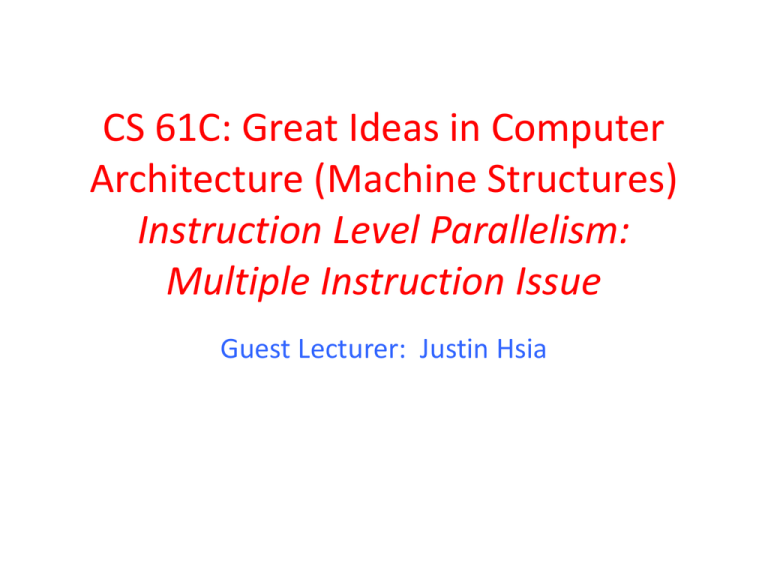
CS 61C: Great Ideas in Computer Architecture (Machine Structures) Instruction Level Parallelism: Multiple Instruction Issue Guest Lecturer: Justin Hsia You Are Here! Software • Parallel Requests Assigned to computer e.g., Search “Katz” Hardware Harness Smart Phone Warehouse Scale Computer • Parallel Threads Parallelism & Assigned to core e.g., Lookup, Ads Achieve High Performance Computer • Parallel Instructions >1 instruction @ one time e.g., 5 pipelined instructions Memory Today’s Lecture Instruction Unit(s) • Hardware descriptions Core Functional Unit(s) A0+B0 A1+B1 A2+B2 A3+B3 Cache All gates functioning in parallel at same time 7/28/2011 Core (Cache) Input/Output • Parallel Data >1 data item @ one time e.g., Add of 4 pairs of words … Core Logic Gates Summer 2011 -- Lecture #23 2 Agenda • • • • • • • • Control Hazards Higher Level ILP Administrivia Dynamic Scheduling Technology Break Example AMD Barcelona Big Picture: Types of Parallelism Summary 7/28/2011 Summer 2011 -- Lecture #23 3 Review: Hazards Situations that prevent starting the next instruction in the next clock cycle 1. Structural hazards – A required resource is busy (e.g., needed in multiple stages) 2. Data hazard – Data dependency between instructions. – Need to wait for previous instruction to complete its data read/write 3. Control hazard – Flow of execution depends on previous instruction 7/28/2011 Summer 2011 -- Lecture #23 4 Review: Load / Branch Delay Slots • Stall is equivalent to nop bub bub ble ble bub ble bub ble bub ble I$ Reg D$ Reg I$ Reg D$ Reg I$ Reg ALU and $t5,$t0,$t4 Reg ALU sub $t3,$t0,$t2 D$ ALU nop I$ ALU lw $t0, 0($t1) D$ Reg or $t7,$t0,$t6 7/28/2011 Summer 2011 -- Lecture #23 5 Agenda • • • • • • • • Control Hazards Higher Level ILP Administrivia Dynamic Scheduling Technology Break Example AMD Barcelona Big Picture: Types of Parallelism Summary 7/28/2011 Summer 2011 -- Lecture #23 6 §4.10 Parallelism and Advanced Instruction Level Parallelism Greater Instruction-Level Parallelism (ILP) • Deeper pipeline (5 => 10 => 15 stages) – Less work per stage shorter clock cycle • Multiple issue is superscalar – Replicate pipeline stages multiple pipelines – Start multiple instructions per clock cycle – CPI < 1, so use Instructions Per Cycle (IPC) – E.g., 4 GHz 4-way multiple-issue • 16 BIPS, peak CPI = 0.25, peak IPC = 4 – But dependencies reduce this in practice 7/28/2011 Summer 2011 -- Lecture #23 7 Multiple Issue • Static multiple issue – Compiler groups instructions to be issued together – Packages them into “issue slots” – Compiler detects and avoids hazards • Dynamic multiple issue – CPU examines instruction stream and chooses instructions to issue each cycle – Compiler can help by reordering instructions – CPU resolves hazards using advanced techniques at runtime 7/28/2011 Summer 2011 -- Lecture #23 8 Superscalar Laundry: Parallel per stage 6 PM 7 T a s k 8 9 10 B C O D r d E e r F 12 1 2 AM Time 3030 30 30 30 A 11 (light clothing) (dark clothing) (very dirty clothing) (light clothing) (dark clothing) (very dirty clothing) • More resources, HW to match mix of parallel tasks? 7/28/2011 Summer 2011 -- Lecture #23 9 Pipeline Depth and Issue Width • Intel Processors over Time Microprocessor Year Clock Rate i486 1989 Pentium Pipeline Stages Issue width Cores Power 25 MHz 5 1 1 5W 1993 66 MHz 5 2 1 10W Pentium Pro 1997 200 MHz 10 3 1 29W P4 Willamette 2001 2000 MHz 22 3 1 75W P4 Prescott 2004 3600 MHz 31 3 1 103W Core 2 Conroe 2006 2930 MHz 14 4 2 75W Core 2 Yorkfield 2008 2930 MHz 16 4 4 95W Core i7 Gulftown 2010 3460 MHz 16 4 6 130W 7/28/2011 Summer 2011 -- Lecture #23 10 Pipeline Depth and Issue Width 10000 Clock 1000 Power Pipeline Stages 100 Issue width 10 Cores 1 1989 1992 1995 1998 2001 2004 2007 2010 7/28/2011 Summer 2011 -- Lecture #23 11 Static Multiple Issue • Compiler groups instructions into issue packets – Group of instructions that can be issued on a single cycle – Determined by pipeline resources required • Think of an issue packet as a very long instruction (VLIW) – Specifies multiple concurrent operations 7/28/2011 Summer 2011 -- Lecture #23 12 Scheduling Static Multiple Issue • Compiler must remove some/all hazards – Reorder instructions into issue packets – No dependencies with a packet – Possibly some dependencies between packets • Varies between ISAs; compiler must know! – Pad with nop if necessary 7/28/2011 Summer 2011 -- Lecture #23 13 MIPS with Static Dual Issue • Dual-issue packets – One ALU/branch instruction – One load/store instruction – 64-bit aligned • ALU/branch, then load/store • Pad an unused instruction with nop 7/28/2011 Address Instruction type Pipeline Stages n ALU/branch IF ID EX MEM WB n+4 Load/store IF ID EX MEM WB n+8 ALU/branch IF ID EX MEM WB n + 12 Load/store IF ID EX MEM WB n + 16 ALU/branch IF ID EX MEM WB n + 20 Load/store IF ID EX MEM WB Summer 2011 -- Lecture #23 14 Hazards in the Dual-Issue MIPS • More instructions executing in parallel • EX data hazard – Forwarding avoided stalls with single-issue – Now can’t use ALU result in load/store in same packet • add $t0, $s0, $s1 load $s2, 0($t0) • Split into two packets, effectively a stall • Load-use hazard – Still one cycle use latency, but now two instructions • More aggressive scheduling required 7/28/2011 Summer 2011 -- Lecture #23 15 Scheduling Example • Schedule this for dual-issue MIPS Loop: lw addu sw addi bne Loop: 7/28/2011 $t0, $t0, $t0, $s1, $s1, 0($s1) $t0, $s2 0($s1) $s1,–4 $zero, Loop # # # # # $t0=array element add scalar in $s2 store result decrement pointer branch $s1!=0 ALU/branch Load/store cycle nop lw 1 addi $s1, $s1,–4 nop 2 addu $t0, $t0, $s2 nop 3 bne sw $s1, $zero, Loop $t0, 0($s1) $t0, 4($s1) 4 IPC = 5/4 = 1.25 (c.f. peak IPC = 2) Summer 2011 -- Lecture #23 16 Loop Unrolling • Replicate loop body to expose more parallelism • Use different registers per replication – Called register renaming – Avoid loop-carried anti-dependencies • Store followed by a load of the same register • Aka “name dependence” – Reuse of a register name 7/28/2011 Summer 2011 -- Lecture #23 17 Loop Unrolling Example Loop: ALU/branch Load/store cycle addi $s1, $s1,–16 lw $t0, 0($s1) 1 nop lw $t1, 12($s1) 2 addu $t0, $t0, $s2 lw $t2, 8($s1) 3 addu $t1, $t1, $s2 lw $t3, 4($s1) 4 addu $t2, $t2, $s2 sw $t0, 16($s1) 5 addu $t3, $t4, $s2 sw $t1, 12($s1) 6 nop sw $t2, 8($s1) 7 sw $t3, 4($s1) 8 bne $s1, $zero, Loop • IPC = 14/8 = 1.75 – Closer to 2, but at cost of registers and code size 7/28/2011 Summer 2011 -- Lecture #23 18 Agenda • • • • • • • • Control Hazards Higher Level ILP Administrivia Dynamic Scheduling Technology Break Example AMD Barcelona Big Picture: Types of Parallelism Summary 7/28/2011 Summer 2011 -- Lecture #23 19 Administrivia • Project 2 Part 2 due Sunday. – Slides at end of July 12 lecture contain useful info. • Lab 12 cancelled! – Replaced with free study session where you can catch up on labs / work on project 2. – The TAs will still be there. • Project 3 will be posted late Sunday (7/31) – Two-stage pipelined CPU in Logisim 7/28/2011 Summer 2011 -- Lecture #23 20 Agenda • • • • • • • • Control Hazards Administrivia Higher Level ILP Dynamic Scheduling Technology Break Example AMD Barcelona Big Picture: Types of Parallelism Summary 7/28/2011 Summer 2011 -- Lecture #23 21 Dynamic Multiple Issue • “Superscalar” processors • CPU decides whether to issue 0, 1, 2, … instructions each cycle – Avoiding structural and data hazards • Avoids need for compiler scheduling – Though it may still help – Code semantics ensured by the CPU 7/28/2011 Summer 2011 -- Lecture #23 22 Dynamic Pipeline Scheduling • Allow the CPU to execute instructions out of order to avoid stalls – But commit result to registers in order • Example lw $t0, 20($s2) addu $t1, $t0, $t2 subu $s4, $s4, $t3 slti $t5, $s4, 20 – Can start subu while addu is waiting for lw 7/28/2011 Summer 2011 -- Lecture #23 23 Why Do Dynamic Scheduling? • Why not just let the compiler schedule code? • Not all stalls are predicable – e.g., cache misses • Can’t always schedule around branches – Branch outcome is dynamically determined • Different implementations of an ISA have different latencies and hazards 7/28/2011 Summer 2011 -- Lecture #23 24 Speculation • “Guess” what to do with an instruction – Start operation as soon as possible – Check whether guess was right • If so, complete the operation • If not, roll-back and do the right thing • Common to both static and dynamic multiple issue • Examples – Speculate on branch outcome (Branch Prediction) • Roll back if path taken is different – Speculate on load • Roll back if location is updated 7/28/2011 Summer 2011 -- Lecture #23 25 Pipeline Hazard: Matching socks in later load 6 PM 7 T a s k 8 9 10 3030 30 30 30 30 30 A 11 12 1 2 AM Time bubble B C O D r d E e r F • A depends on D; stall since folder tied up; 7/28/2011 Summer 2011 -- Lecture #23 26 Out-of-Order Laundry: Don’t Wait 6 PM 7 T a s k 8 9 10 3030 30 30 30 30 30 A 11 12 1 2 AM Time bubble B C O D r d E e r F • A depends on D; rest continue; need more resources to allow out-of-order 7/28/2011 Summer 2011 -- Lecture #23 27 Out-of-Order Execution (1/3) Basically, unroll loops in hardware 1. Fetch instructions in program order (≤4/clock) 2. Predict branches as taken/untaken 3. To avoid hazards on registers, rename registers using a set of internal registers (~80 registers) 7/28/2011 Summer 2011 -- Lecture #23 28 Out-of-Order Execution (2/3) Basically, unroll loops in hardware 4. Collection of renamed instructions might execute in a window (~60 instructions) 5. Execute instructions with ready operands in 1 of multiple functional units (ALUs, FPUs, Ld/St) 6. Buffer results of executed instructions until predicted branches are resolved in reorder buffer 7/28/2011 Summer 2011 -- Lecture #23 29 Out-of-Order Execution (3/3) Basically, unroll loops in hardware 7. If predicted branch correctly, commit results in program order 8. If predicted branch incorrectly, discard all dependent results and start with correct PC 7/28/2011 Summer 2011 -- Lecture #23 30 Dynamically Scheduled CPU Preserves dependencies Branch prediction, Register renaming Wait here until all operands available Execute… Results also sent to any waiting reservation stations … and Hold Reorder buffer for register and memory writes 7/28/2011 Can supply operands for issued instructions Summer 2011 -- Lecture #23 31 Out-Of-Order Intel • All use O-O-O since 2001 Microprocessor Year Clock Rate Pipeline Stages Issue width Out-of-order/ Speculation Cores Power i486 1989 25MHz 5 1 No 1 5W Pentium 1993 66MHz 5 2 No 1 10W Pentium Pro 1997 200MHz 10 3 Yes 1 29W P4 Willamette 2001 2000MHz 22 3 Yes 1 75W P4 Prescott 2004 3600MHz 31 3 Yes 1 103W Core 2006 2930MHz 14 4 Yes 2 75W Core 2 Yorkfield 2008 2930 MHz 16 4 Yes 4 95W Core i7 Gulftown 2010 3460 MHz 16 4 Yes 6 130W 7/28/2011 Summer 2011 -- Lecture #23 32 Agenda • • • • • • • • Control Hazards Administrivia Higher Level ILP Dynamic Scheduling Technology Break Example AMD Barcelona Big Picture: Types of Parallelism Summary 7/28/2011 Summer 2011 -- Lecture #23 33 Agenda • • • • • • • • Control Hazards Administrivia Higher Level ILP Dynamic Scheduling Technology Break Example AMD Barcelona Big Picture: Types of Parallelism Summary 7/28/2011 Summer 2011 -- Lecture #23 34 §4.11 Real Stuff: The AMD Opteron X4 (Barcelona) Pipeline AMD Opteron X4 Microarchitecture x86 instructions 16 architectural registers 72 physical registers RISC operations renaming Queues: - 106 RISC ops - 24 integer ops - 36 FP/SSE ops - 44 ld/st 7/28/2011 Summer 2011 -- Lecture #23 35 AMD Opteron X4 Pipeline Flow • For integer operations 12 stages (Floating Point is 17 stages) Up to 106 RISC-ops in progress • Intel Nehalem is 16 stages for integer operations, details not revealed, but likely similar to above. Intel calls RISC operations “Micro operations” or “μops” 7/28/2011 Summer 2011 -- Lecture #23 36 Does Multiple Issue Work? The BIG Picture • Yes, but not as much as we’d like • Programs have real dependencies that limit ILP • Some dependencies are hard to eliminate – e.g., pointer aliasing • Some parallelism is hard to expose – Limited window size during instruction issue • Memory delays and limited bandwidth – Hard to keep pipelines full • Speculation can help if done well 7/28/2011 Summer 2011 -- Lecture #23 37 Agenda • • • • • • • Higher Level ILP Administrivia Dynamic Scheduling Example AMD Barcelona Technology Break Big Picture: Types of Parallelism Summary 7/28/2011 Summer 2011 -- Lecture #23 38 New-School Machine Structures (It’s a bit more complicated!) Lab 14 Software • Parallel Requests Assigned to computer e.g., Search “Katz” Hardware Harness Smart Phone Warehouse Scale Computer • Parallel Threads Parallelism & Assigned to core e.g., Lookup, Ads Achieve High Performance Project 1 • Parallel Instructions >1 instruction @ one time e.g., 5 pipelined instructions • Parallel Data >1 data item @ one time e.g., Add of 4 pairs of words • Hardware descriptions All gates functioning in parallel at same time 7/28/2011 Computer … Core Memory Core (Cache) Input/Output Instruction Unit(s) Project 2 Core Functional Unit(s) A0+B0 A1+B1 A2+B2 A3+B3 Main Memory Summer 2011 -- Lecture #23 Logic Gates Project 39 3 Big Picture on Parallelism Two types of parallelism in applications 1. Data-Level Parallelism (DLP): arises because there are many data items that can be operated on at the same time 2. Task-Level Parallelism: arises because tasks of work are created that can operate largely in parallel 7/28/2011 Summer 2011 -- Lecture #23 40 Big Picture on Parallelism Hardware can exploit app DLP and Task LP in four ways: 1. Instruction-Level Parallelism: Hardware exploits application DLP using ideas like pipelining and speculative execution 2. SIMD architectures: exploit app DLP by applying a single instruction to a collection of data in parallel 3. Thread-Level Parallelism: exploits either app DLP or TLP in a tightly-coupled hardware model that allows for interaction among parallel threads 4. Request-Level Parallelism: exploits parallelism among largely decoupled tasks and is specified by the programmer of the operating system 7/28/2011 Summer 2011 -- Lecture #23 41 Peer Instruction Instr LP, SIMD, Thread LP, Request LP are examples of • Parallelism above the Instruction Set Architecture • Parallelism explicitly at the level of the ISA • Parallelism below the level of the ISA Red Green Purple Blue 7/28/2011 Inst. LP SIMD Thr. LP = = = ∨ = = = = ∧ ∨ = ∧ = ∧ ∧ ∧ Summer 2011∧ ∧ -- Lecture #23 Req. LP ∧ ∧ ∧ ∧ ∧ ∧ 42 Peer Answer Instr LP, SIMD, Thread LP, Request LP are examples of • Parallelism above the Instruction Set Architecture • Parallelism explicitly at the level of the ISA • Parallelism below the level of the ISA Red Green Purple Blue 7/28/2011 Inst. LP SIMD Thr. LP = = = ∨ = = = = ∧ ∨ = ∧ = ∧ ∧ ∧ Summer 2011∧ ∧ -- Lecture #23 Req. LP ∧ ∧ ∧ ∧ ∧ ∧ 43 Peer Question State if the following techniques are associated primarily with a software- or hardware-based approach to exploiting ILP (in some cases, the answer may be both): Superscalar, Out-ofOrder execution, Speculation, Register Renaming Red Green Purple Blue 7/28/2011 Superscalar HW SW Both HW HW HW Out of Specu- Register Order lation Renaming HW HW HW SW SW SW Both Both Both HW Both Both HW HW Both HW HW SW Summer 2011 -- Lecture #23 44 Peer Answer State if the following techniques are associated primarily with a software- or hardware-based approach to exploiting ILP (in some cases, the answer may be both): Superscalar, Out-ofOrder execution, Speculation, Register Renaming Red Orange Green Pink Blue 7/28/2011 Superscalar HW SW Both HW HW HW Out of Specu- Register Order lation Renaming HW HW HW SW SW SW Both Both Both HW Both Both HW HW Both HW HW SW Summer 2011 -- Lecture #23 45 “And in Conclusion, …” • • • • Big Ideas of Instruction Level Parallelism Pipelining, Hazards, and Stalls Forwarding, Speculation to overcome Hazards Multiple issue to increase performance – IPC instead of CPI • Dynamic Execution: Superscalar in-order issue, branch prediction, register renaming, out-oforder execution, in-order commit – “unroll loops in HW”, hide cache misses 7/28/2011 Summer 2011 -- Lecture #23 46 But wait… there’s more??? If we have time… Review: C Memory Management ~ FFFF FFFFhex • C has three pools of data memory (+ code memory) – Static storage: global variable storage, basically permanent, entire program run – The Stack: local variable storage, parameters, return address – The Heap (dynamic storage): malloc() grabs space from here, free() returns it heap • Common (Dynamic) Memory Problems – Using uninitialized values – Accessing memory beyond your allocated region – Improper use of free/realloc by messing with the pointer handle returned by malloc – Memory leaks: mismatched malloc/free pairs 7/28/2011 Summer 2011 -- Lecture #23 stack static data code ~ 0hex OS prevents accesses between stack and heap (via virtual memory) 48 Simplest Model • Only one program running on the computer – Addresses in the program are exactly the physical memory addresses • Extensions to the simple model: – What if less physical memory than full address space? – What if we want to run multiple programs at the same time? 7/28/2011 Summer 2011 -- Lecture #23 49 Problem #1: Physical Memory Less Than the Full Address Space • One architecture, ~ FFFF FFFF many implementations, with possibly different amounts of memory • Memory used to very expensive and physically bulky • Where does the stack ~ 0 grow from then? hex stack heap static data code hex 7/28/2011 “Logical” “Virtual” Summer 2011 -- Lecture #23 Real 50 Idea: Level of Indirection to Create Illusion of Large Physical Memory Hi Order Bits of Virtual Address ~ FFFF FFFFhex stack Address Map or Table Hi Order Bits of Physical Address 7 6 5 4 3 heap 2 static data 1 ~ 0hex code “Logical” “Virtual” 7/28/2011 0 Virtual “Page” Address Summer 2011 -- Lecture #23 Physical “Page” Address Real 51 Problem #2: Multiple Programs Sharing the Machine’s Address Space • How can we run ~ FFFF FFFF multiple programs without accidentally stepping on same addresses? • How can we protect programs ~0 from clobbering each other? hex stack stack heap heap static data static data code hex 7/28/2011 ~ FFFF FFFFhex Application 1 Summer 2011 -- Lecture #23 ~ 0hex code Application 2 52 Idea: Level of Indirection to Create Illusion of Separate Address Spaces ~ FFFF FFFFhex stack 7 7 6 6 static data 5 5 code 4 4 3 3 2 2 1 1 0 0 heap ~ 0hex ~ FFFF FFFFhex stack heap static data ~ 0hex 7/28/2011 code One table per running application OR swap table contents when switching Summer 2011 -- Lecture #23 Real 53 Extension to the Simple Model • Multiple programs sharing the same address space – E.g., Operating system uses low end of address range shared with application – Multiple programs in shared (virtual) address space • Static management: fixed partitioning/allocation of space • Dynamic management: programs come and go, take different amount of time to execute, use different amounts of memory • How can we protect programs from clobbering each other? • How can we allocate memory to applications on demand? 7/28/2011 Summer 2011 -- Lecture #23 54 Static Division of Shared Address Space ~ FFFF FFFFhex stack Application (4 GB - 64 MB) heap static data ~ 1000 0000hex ~ 0FFF FFFFhex 228 bytes (64 MB) ~ 0hex 7/28/2011 code stack heap Operating System • E.g., how to manage the carving up of the address space among OS and applications? • Where does the OS end and the application begin? • Dynamic management, with protection, would be better! static data code Summer 2011 -- Lecture #23 55 First Idea: Base + Bounds Registers for Location Independence Max addr Programming and storage management ease: need for a base register prog1 Protection Independent programs should not affect each other inadvertently: need for a bound register 0 addr Physical Memory Location-independent programs prog2 Historically, base + bounds registers were a very early idea in computer architecture 7/28/2011 Summer 2011 -- Lecture #23 56 Simple Base and Bound Translation Segment Length lw X Effective Address Bounds Violation? + Physical Address Physical Memory Bound Register current segment Base Register Base Physical Address Program Address Space Base and bounds registers are visible/accessible to programmer Trap to OS if bounds violation detected (“seg fault”/”core dumped”) 7/28/2011 Summer 2011 -- Lecture #23 57 Programs Sharing Memory OS Space pgms 4 & 5 arrive OS Space pgm 1 16K pgm 1 16K pgm 2 24K pgm 2 pgm 4 24K 32K pgm 3 16K 8K 32K 24K pgm 5 24K 24K pgm 3 pgms 2 & 5 leave free OS Space pgm 1 16K 24K pgm 4 16K 8K pgm 3 32K 24K Why do we want to run multiple programs? Run others while waiting for I/O What prevents programs from accessing each other’s data? 7/28/2011 Summer 2011 -- Lecture #23 58 Student Roulette? Restriction on Base + Bounds Regs Want only the Operating System to be able to change Base and Bound Registers Processors need different execution modes 1. User mode: can use Base and Bound Registers, but cannot change them 2. Supervisor mode: can use and change Base and Bound Registers – Also need Mode Bit (0=User, 1=Supervisor) to determine processor mode – Also need way for program in User Mode to invoke operating system in Supervisor Mode, and vice versa 7/28/2011 Summer 2011 -- Lecture #23 59 Programs Sharing Memory OS Space pgms 4 & 5 arrive OS Space pgm 1 16K pgm 1 16K pgm 2 24K pgm 2 pgm 4 24K 32K pgm 3 16K 8K 32K 24K pgm 5 24K 24K pgm 3 pgms 2 & 5 leave pgm 1 free OS Space 16K 24K pgm 4 16K 8K pgm 3 32K 24K As programs come and go, the storage is “fragmented”. Therefore, at some stage programs have to be moved around to compact the storage. Easy way to do this? 7/28/2011 Summer 2011 -- Lecture #23 60 Student Roulette?
